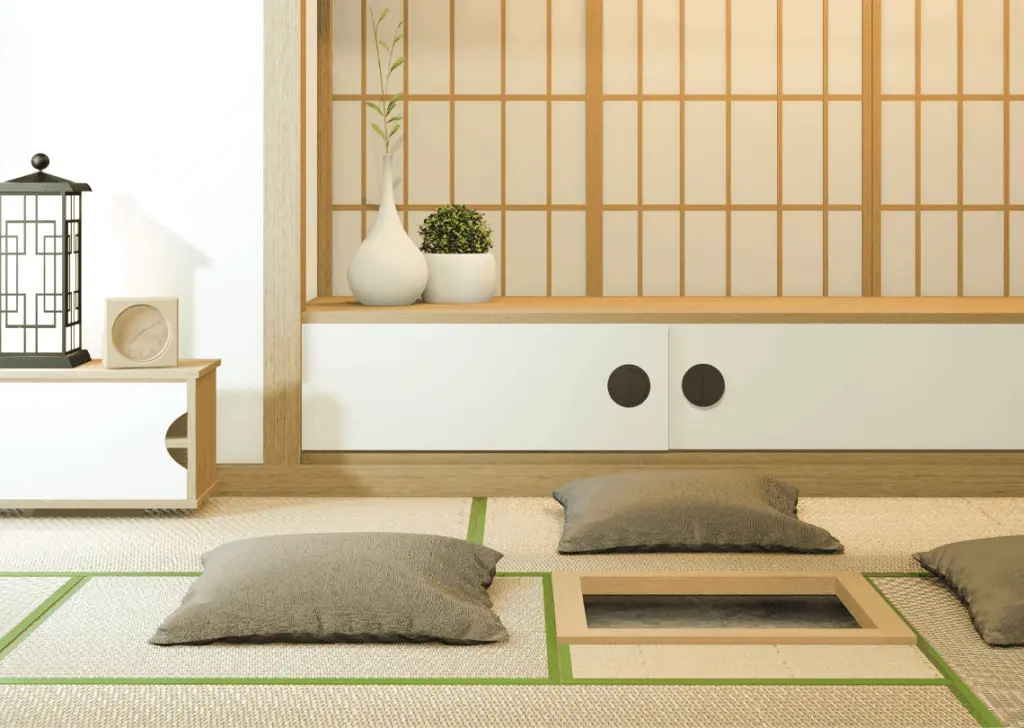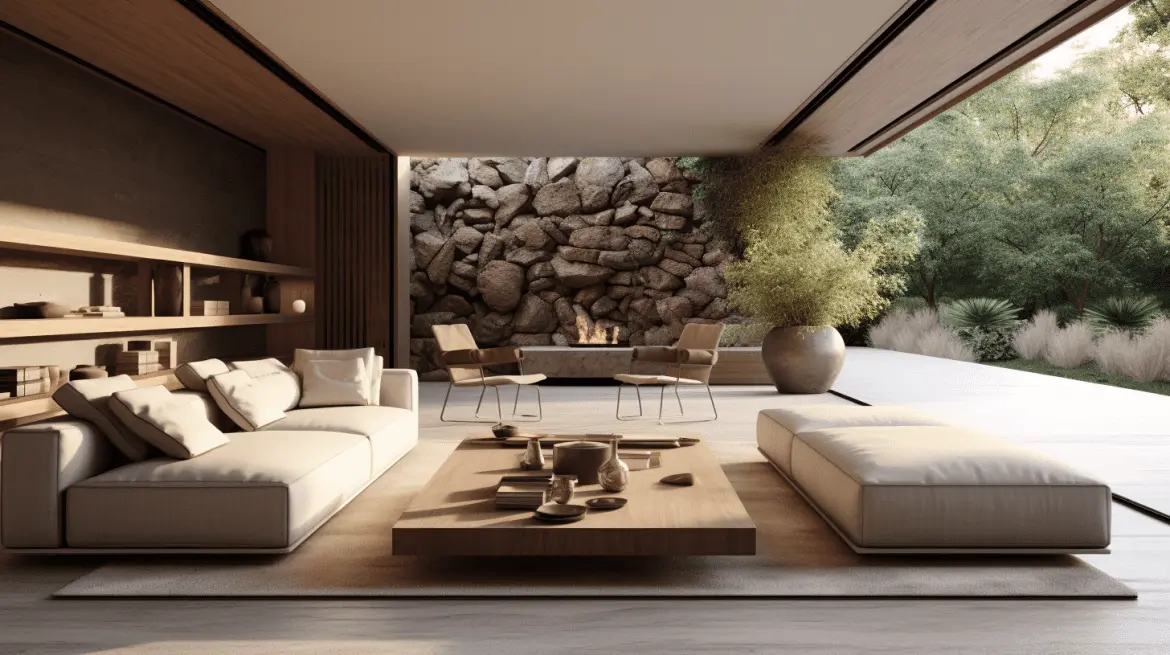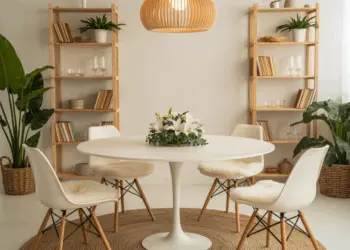Japandi Living Room design is a journey toward creating a space that not only looks beautiful but also enhances your quality of life.
In the world of interior design, the fusion of cultures and styles often leads to the creation of unique and captivating decor themes. One such emerging trend that has gained immense popularity in recent years is the “Japandi” style. This design approach seamlessly marries the minimalism and functionality of Scandinavian design with the timeless elegance and tranquility of Japanese aesthetics.
In this article, we will take a closer look at Japandi style living rooms, exploring their key elements, how to achieve this look, and why it has become a preferred choice for many homeowners.
Table of Contents
Japandi Style
Japandi style, as the name suggests, is a design philosophy that combines elements of Japanese and Scandinavian interior design. It’s all about finding the perfect balance between simplicity, functionality, and aesthetics. This style focuses on creating a harmonious living space that promotes relaxation and well-being.
The Core Principles of Japandi Design
2.1 Minimalism
At the heart of Japandi design is minimalism. It encourages the removal of clutter and unnecessary elements, leaving behind only what is essential. This creates a sense of serenity and spaciousness in your living room.
2.2 Natural Materials
Japandi style emphasizes the use of natural materials like wood, stone, and bamboo. These materials add warmth and a connection to nature to your living space.
2.3 Neutral Color Palette
The color palette in a Japandi living room is typically neutral, with an emphasis on whites, grays, and muted earthy tones. This choice of colors creates a calming and timeless atmosphere.
2.4 Functional Furniture
Furniture in a Japandi living room is chosen for both its aesthetics and functionality. Pieces are sleek, with clean lines and a focus on usability.

Creating a Japandi Living Room
Now that you have a solid understanding of the core principles of Japandi design, let’s delve deeper into how you can effectively incorporate these elements into your living room.
3.1 Furniture Selection for your Japandi Living Room
When selecting furniture, prioritize pieces with clean lines and a focus on functionality. Japandi style often features low-profile seating and tables. Look for wooden furniture with a natural finish, as this complements the aesthetic beautifully. Remember, less is more in Japandi design, so choose your pieces thoughtfully.
3.2 Textures and Fabrics for your Japandi Living Room
Texture plays a vital role in adding warmth and depth to your Japandi living room. Incorporate textiles made from natural fibers like cotton, linen, and wool. Think about adding cushions with subtle patterns or earthy tones to create visual interest without overwhelming the space.
3.3 Lighting for your Japandi Living Room
Lighting should create a soft and inviting atmosphere. Paper lanterns or pendant lights made of natural materials like bamboo or rice paper are excellent choices. Consider using floor lamps with warm, ambient bulbs to illuminate specific areas of the room.
3.4 Decorative Elements for your Japandi Living Room
While Japandi style emphasizes minimalism, carefully chosen decorative elements can enhance the overall look. Consider introducing elements like bonsai trees, Ikebana flower arrangements, or ceramics in muted hues. These items should not clutter the space but rather accentuate the tranquility of the room.

Embracing Zen Living With Japandi Living Room
Japandi style isn’t just about aesthetics; it also encourages a more mindful way of living. Here are some tips to help you embrace the Zen philosophy within your Japandi living room:
4.1 Declutter Regularly
To maintain the serenity of your living space, make decluttering a habit. Regularly assess your decor items and furniture to ensure they align with the Japandi ethos of simplicity.
4.2 Mindful Living
Japandi design encourages a focus on the present moment. Incorporate mindfulness practices such as meditation or yoga into your daily routine within the living room. Create a designated corner with comfortable cushions and soft lighting for this purpose.
4.3 Sustainable Living
Another aspect of Japandi style is an appreciation for sustainability. Choose eco-friendly materials and products when decorating your living room. This not only aligns with the principles of Japandi but also contributes to a more environmentally conscious lifestyle.

The Benefits of Japandi Living
5.1 Tranquility
A Japandi living room is a sanctuary of tranquility. The minimalist design and natural elements promote a sense of calm and relaxation, making it the perfect place to unwind after a long day.
5.2 Timelessness
Japandi style is not a passing trend. Its timeless appeal ensures that your living room will remain fashionable and relevant for years to come.
5.3 Versatility
One of the remarkable aspects of Japandi style is its versatility. Whether you have a small apartment or a spacious home, this design approach adapts beautifully to various living spaces.
5.4 Personal Wellness
The emphasis on mindfulness and the connection to nature in Japandi living can positively impact your overall well-being. It fosters an environment that promotes mental and emotional wellness.

Maintaining Simplicity and Functionality in your Japandi Living Room
One of the key principles of Japandi style is simplicity. Avoid overcrowding your living room with too many items or unnecessary decor. Each piece should have a purpose.
Adding a Touch of Nature in your Japandi Living Room
Bringing the outdoors inside is a crucial aspect of Japandi design. Incorporate indoor plants to infuse your living room with a sense of vitality and tranquility.

Japandi vs. Minimalism: Key Differences
While Japandi shares similarities with minimalism, it distinguishes itself through its subtle infusion of Japanese culture and its emphasis on creating a warm and inviting atmosphere.

Why Choose Japandi Style for Your Living Room?
Japandi style offers a unique blend of functionality and aesthetics. It’s an excellent choice for those who appreciate simplicity, natural elements, and a calming atmosphere in their living spaces.
Inspiring Japandi Living Room design Ideas
To spark your creativity, here are some inspiring Japandi style living room ideas:
- Incorporate a shoji screen as a room divider.
- Use sliding doors to maximize space.
- Opt for a low, platform-style bed.
- Create a zen garden in a corner of the room.

Budget-Friendly Japandi Makeover
You don’t need to break the bank to achieve the Japandi look. Thrift stores and online marketplaces often have affordable furniture and decor items that fit the style.
Tips for Personalizing Your Japandi Living Room
While Japandi is known for its minimalism, don’t be afraid to add personal touches to make your living room truly your own.

Caring for Your Japandi Furnishings
Proper maintenance is essential to preserve the beauty and functionality of your Japandi furniture and decor items. Regular dusting and cleaning are key.

Incorporating Japandi style into your living room can transform it into a tranquil and aesthetically pleasing space. By adhering to the core principles of minimalism, natural materials, and functionality, you can create a harmonious environment that promotes well-being.
FAQs
Is Japandi style suitable for small living rooms?
Absolutely! Japandi style’s minimalistic approach is perfect for maximizing space in smaller rooms.
Where can I find authentic Japandi furniture?
Look for specialized furniture stores, both online and offline, that focus on Japanese and Scandinavian designs.
Can I add pops of color in a Japandi living room?
While Japandi style leans towards neutrals, subtle accents of muted colors can be added for visual interest.
Is Japandi style environmentally friendly?
Yes, Japandi style’s use of natural materials aligns with eco-conscious living.
How can I make my existing furniture fit the Japandi style?
Consider sanding and refinishing wooden furniture or adding simple, neutral slipcovers to sofas and chairs.






